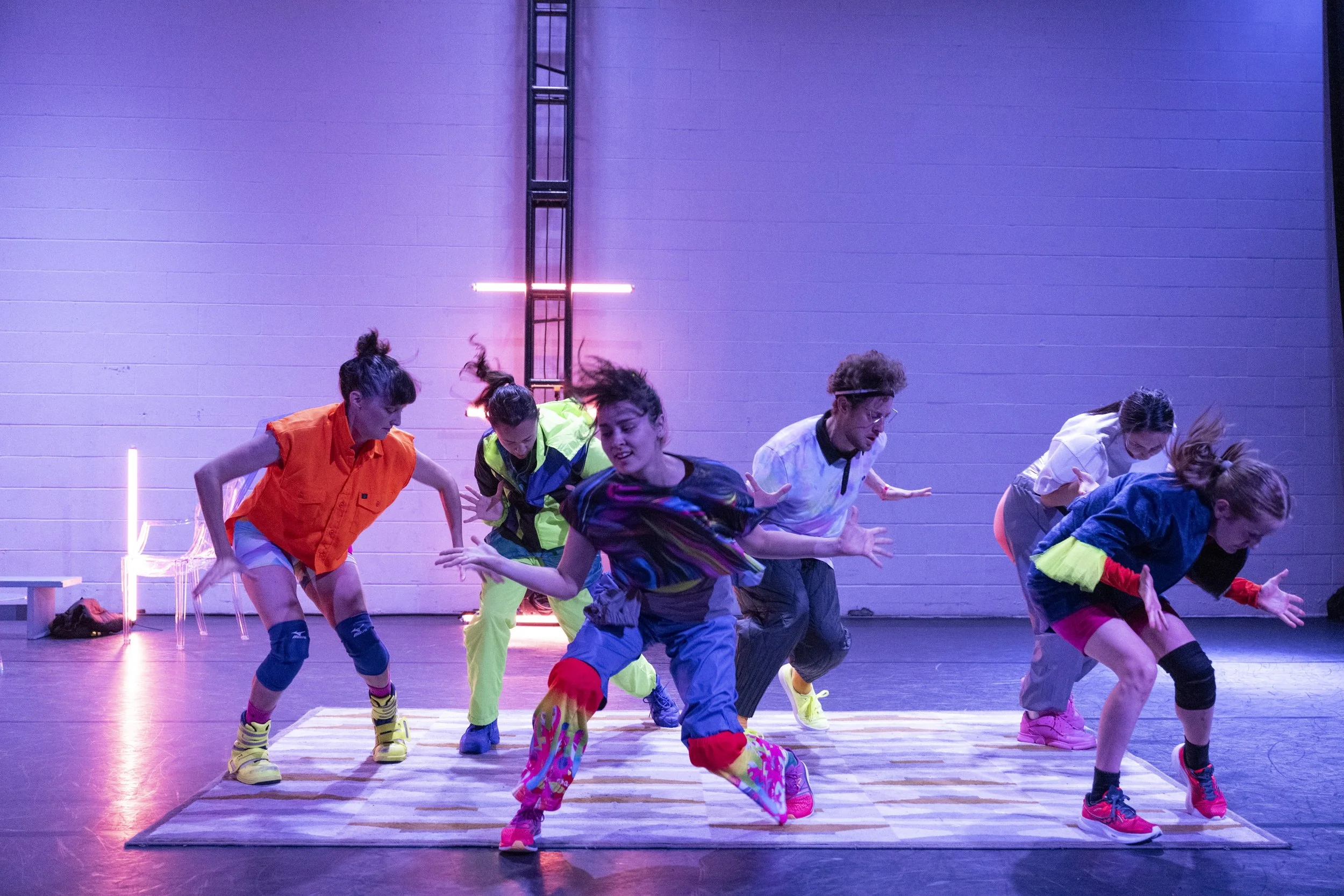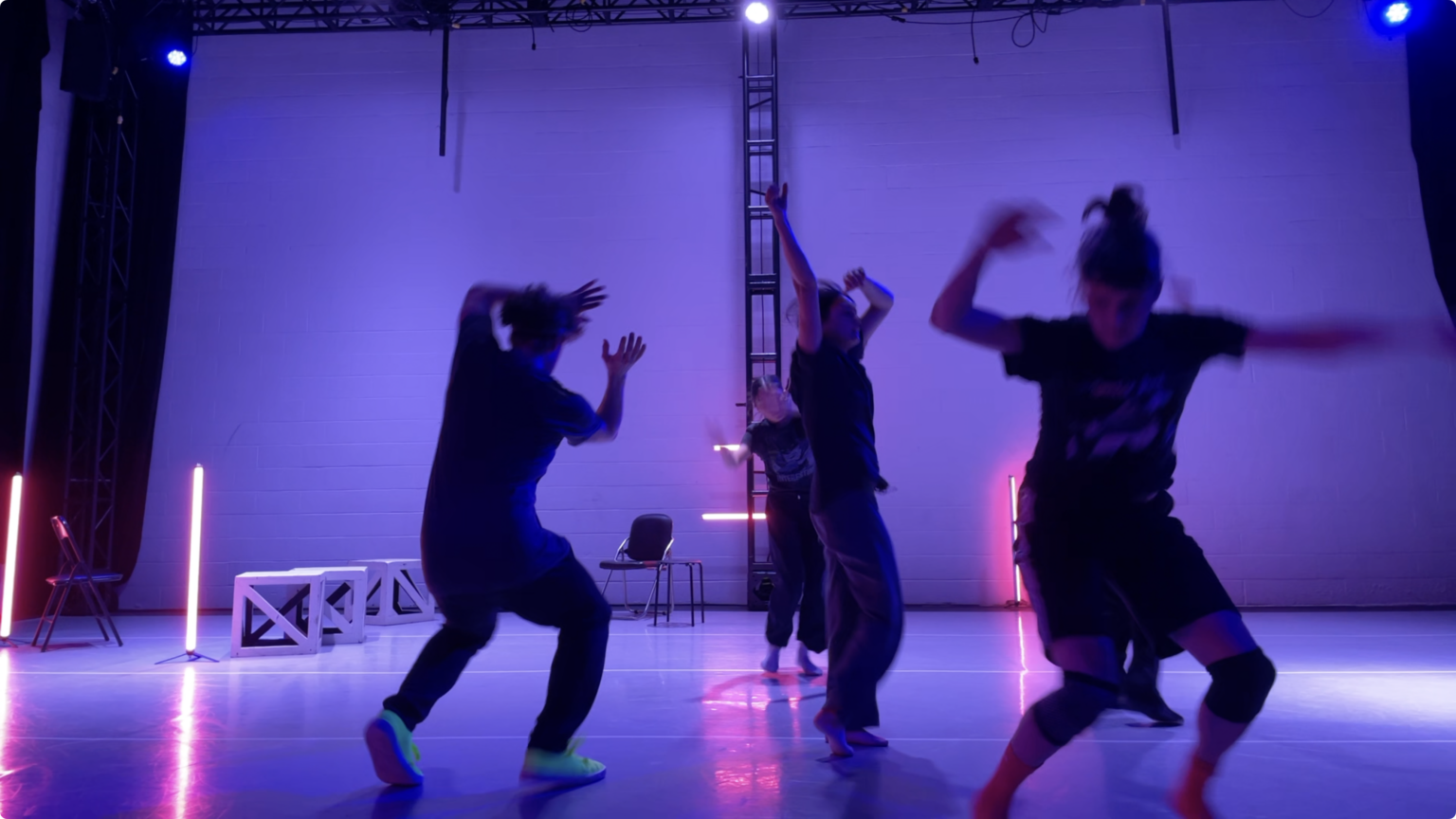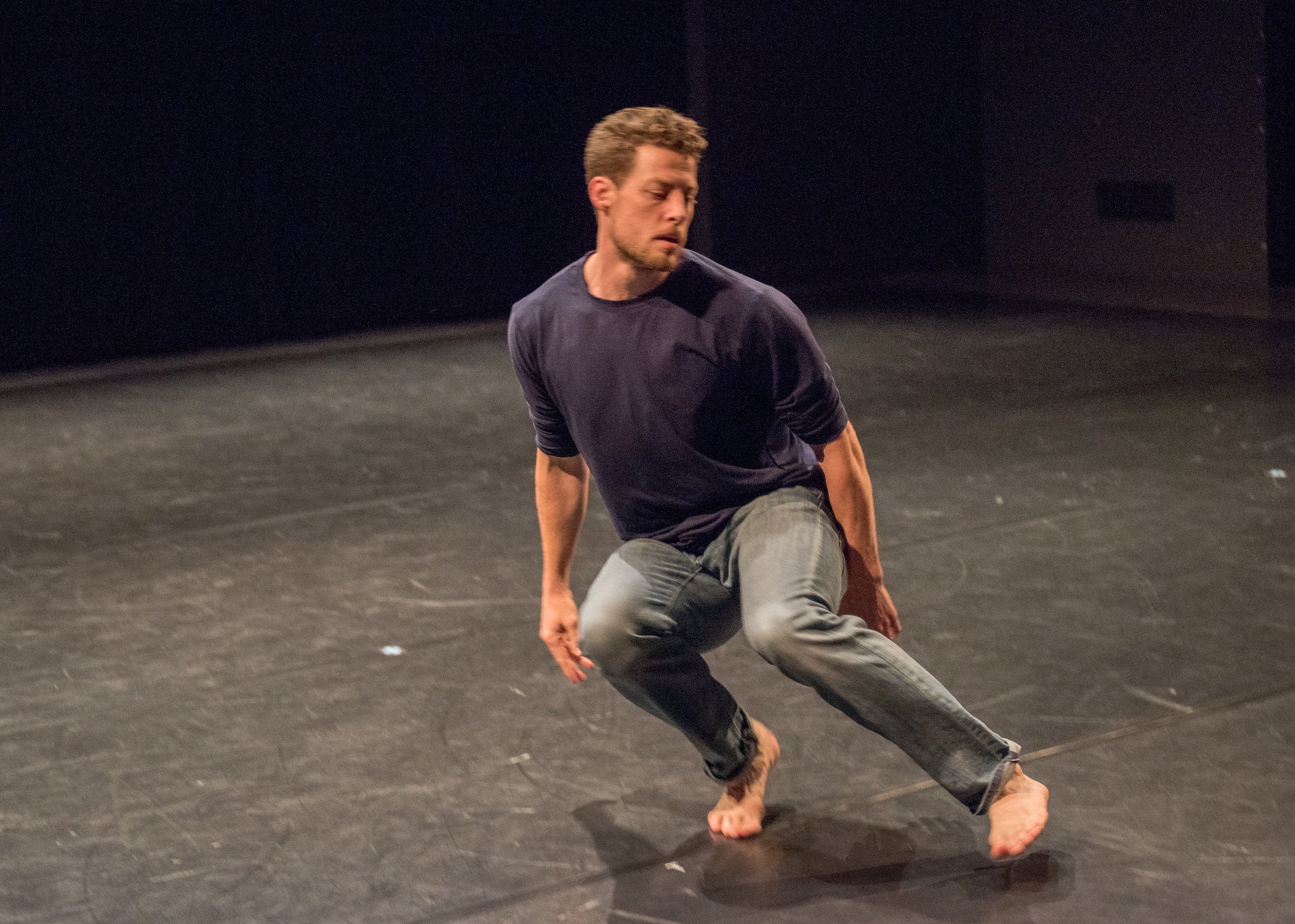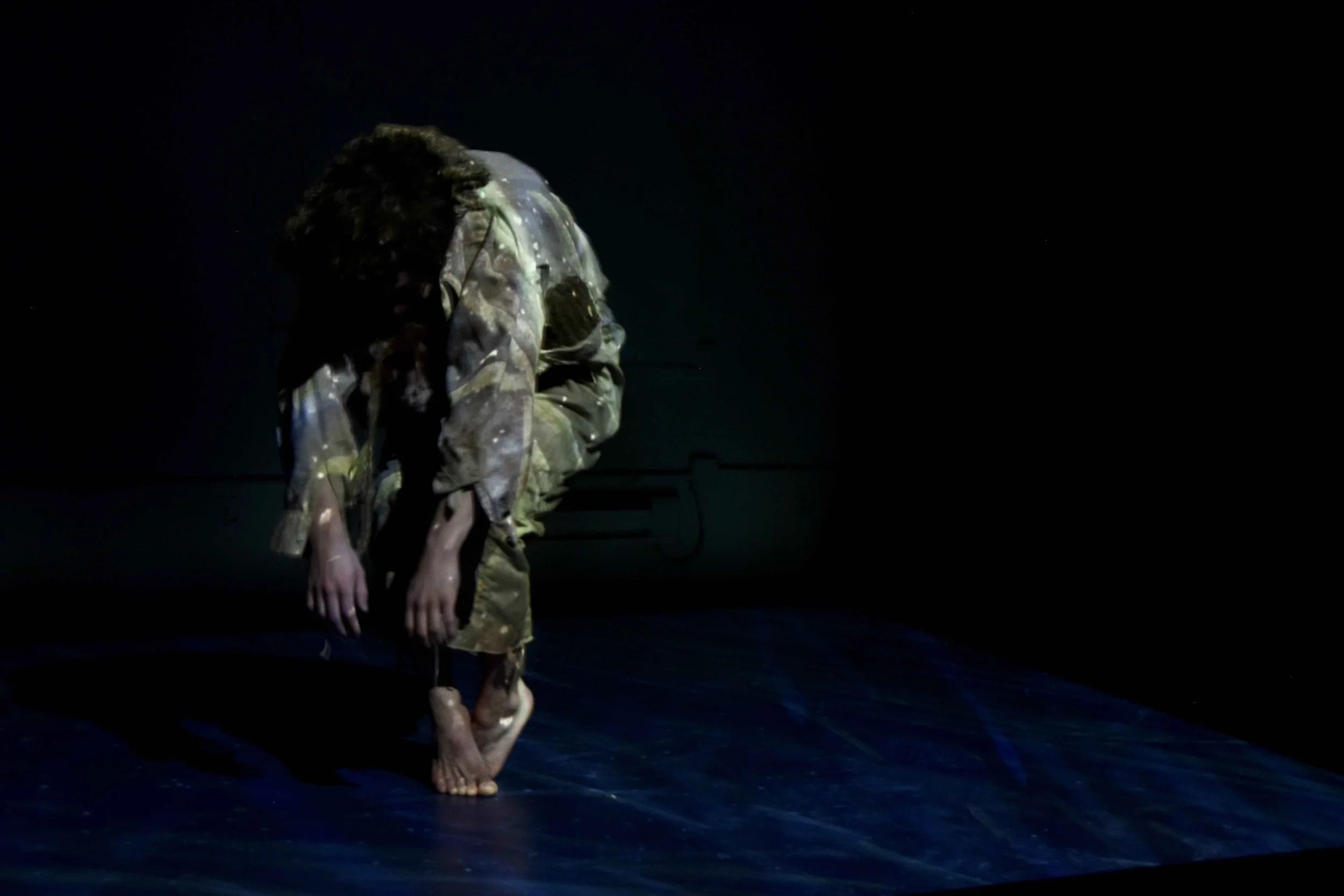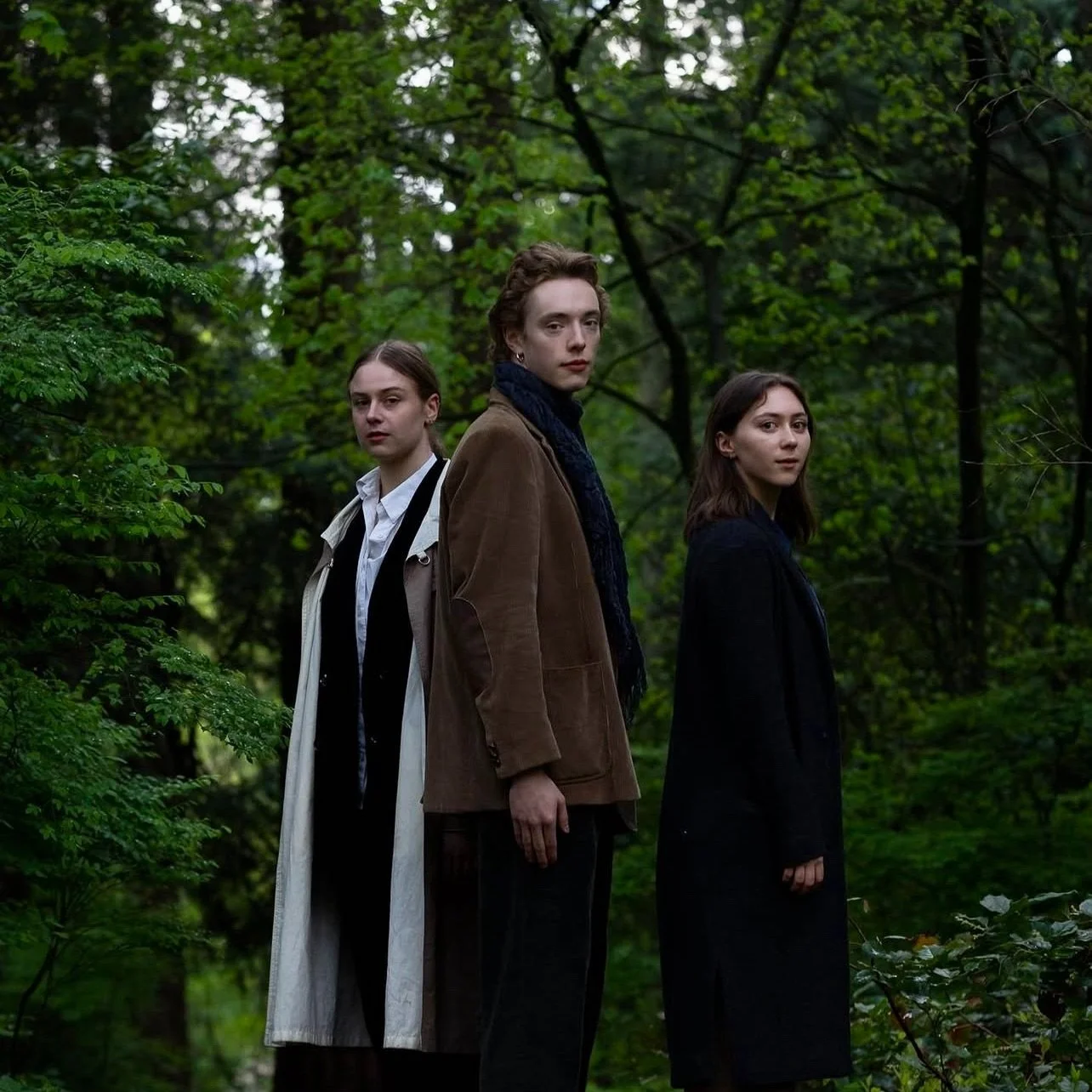Company 605 faces grief and moves forward again with lossy, premiering at Dancing on the Edge
Drawing on the endless scroll of dance fragments online, the new work pushes into fresh territory for the troupe—as does Josh Martin’s new Helen Walkley solo, blocking
Company 605’s lossy. Photo by David Cooper
SOMETIMES AN OVERWHELMING loss can make you wonder how to move forward.
That’s why Company 605’s new work lossy, premiering at this year’s Dancing on the Edge Festival, almost didn’t come to fruition. When co-artistic directors Josh Martin and Lisa Mariko Gelley started out on the work a few years back, they had been exploring ideas about the body’s relationship to the future. Amid finding their way in the wake of the pandemic, they and the rest of the dance community were rocked by the sudden loss of dancer Zahra Shahab in 2022. They started to wonder if they should continue the piece—especially because they couldn’t see the future clearly anymore. As Martin puts it, “There was that shared feeling among us—that sense of paralysis that the future just kind of stops, feeling that block of not knowing how to go on.”
Today the duo and their Company 605 team have taken that journey through grief and loss and reimagined lossy so that it encompasses all that has happened. And in this work, which shifts between fragments of exuberant movement bursts and moments of still limbo, they’ve captured the essence of uncertain times.
“Just reading about grief: you don’t grieve the past so much as you grieve the future. You grieve what’s not going to happen—the future that will never arrive now,” Martin observes in a Zoom interview with Stir, joined by Gelley. “That’s regardless if it’s about a person or a promise of technology, or the idea of better time coming—when you start to take that away and have to regenerate that idea of ‘Where do you go? Where do you conjure that sense of moving forward again?’ In the context of the pandemic, in the context of the war going on in the world, there's grief that we all carry about how we thought things would be and how we thought things would be better.”
lossy. Photo by David Cooper
Out of necessity, in spring 2023, the group shifted gears to figure out how it was going to work in a time of loss. “We had to honour what was possible,” Gelley reflects, adding dramaturg Marcus Youssef came in to help them find a way through.
The resulting piece finds a rich new vocabulary for a period in history when everything feels upside-down. After the struggle, Company 605 has found a new creative energy. (That’s something Martin’s also experiencing in another solo at Dancing on the Edge. But more on that later.)
For all the melancholy moments in lossy, there is also a sense of the way joy and resilience can pull you forward. Martin, who dances in the work with Gelley, Jade Chong, Kate Franklin, Ruby Henderson, Antonio Somera, and Shana 愛 Wolfe, says they started drawing on the energy of random dance clips we’re barraged with constantly on social media—that sense of fragmented chaos. (Not only a play on the word “loss”, the title lossy is also a term for data compression.)
“We built movement for this piece by flipping through Reels of what’s being fed to you constantly—so within that, a lot of pop music and dance music,” he explains. “It feels like there’s a certain mishmash of everything—everything blurring together in a way, just the mess and the flurry of it.”
The pair found a tension in dancers flipping abruptly between movements, like a channel constantly switching within their bodies.
“It was very non-curatorial in the way we came up with movement,” Gelley shares, adding that TikTok and Reels are full of everyday people dancing. “You’re not scrolling through trained dance forms, so there is a party-dance vibe. The way we consume dance now is different—a move is really popular one week, then it’s not.”
Martin points to inspiration in the work of English writer Mark Fisher, late author of Ghosts of My Life: Writings on Depression, Hauntology and Lost Futures. “He has this term ‘hauntology’ for the slow cancellation of future, around the idea that we interact and experience artistic time periods is fading away, and it's turning into this confused, jumbled mess—aesthetic chaos,” Martin explains. “There’s so much recorded and played back to us, the YouTube generation, that this idea of what’s new, or how to pull yourself away from what’s being replayed at you constantly, becomes hard.
“So I think aside from this specific grief, there’s that confusion, too, of ‘Where are we? Where have we landed?’” he continues. “The internet was going to fix everything—all these things were going to happen that were going to make the world better, but in fact we’re just doing the same thing.” He speaks about his personal experience that nothing in music feels new anymore—the industry keeps pulling out things that worked before.
Those deep ideas play out amid a dazzling world in lossy: the dancers are bathed in the glow of neon fluorescent lights, wearing costume-designer Justine A. Chambers’s highlighter-hued clothing, and often lost in their thoughts as they lounge on cold, futuristic Plexiglass furniture. The look captures, as 605 puts it in the show description, “a nostalgia for a world that never happened.”
“We had someone say the piece was a bit like watching old ravers at a funeral,” Martin says with a smile.
Josh Martin in Helen Walkley’s blocking. Photo by Chris Randle
TOUCH WOOD
Company 605 came like a fresh blast of energy on Vancouver’s contemporary dance scene 15 years ago (then as 605 Collective). And lossy—despite the despair that affected it and the fact the pain over Shahab’s loss in the arts scene will never go away—has ended up taking it into new territory again.
That’s something Martin says he’s also experiencing in another solo show at this year’s Dancing on the Edge fest, Helen Walkley’s blocking.
In the piece, Martin takes the stage to interact with more than 200 finely sanded wood blocks—a work of play and discovery that pushes the well-known Vancouver dancer in new directions.
“It is a landscape, and it does feel like a bit of a micro world, and I’m the only inhabitant,” says Martin, who enjoys the sounds the blocks make when they touch each other. “I’m constantly reminded of our nature of creation and destruction—how left on our own, with all of our needs met, what do we do with ourselves? ‘I’m going to make this and then I’m going to wreck it.’”
Walkley and Martin’s artistic relationship has spanned 10 years, Martin dancing in her recent work John. “Creating and performing solos has been a mainstay for me,” Walkley says in a separate interview. “Given Josh and my history, and the understanding that has grown from that history, it made sense to create a solo for and with him, to delve deeper into our processes. This goes together with the long relations I also have with composer James Maxwell and light designer James Proudfoot.
“I appreciate the quality of his attention, his physicality and stamina,” the veteran choreographer adds, “his innovative and thoughtful mind, and his communicative and steady presence.”
Working together through improvisations in the studio, they’ve found the metaphorical, universal power of the simple blocks. Says Walkley: “Children play with blocks. Adults build with blocks. The childlike, whimsical nature of the blocks is conjoined with a non-sequitur chronology. Metaphor is evoked.”
Martin describes Walkley’s process as refining and curating the work’s movement and motifs so that it’s quite a set piece—although the blocks can never quite be arranged or fall the same way twice, so there are always sections of reacting in the moment.
“It does feel different—it becomes a bit of a duet in the way I’m always in relationship with these things that represent so many things,” Martin says. “I am preoccupied. I don't feel so much that I’m on display.”
Martin seems to enjoy that element of reacting in the moment—not just as a dancer but as an authentic human being. It’s an impulse he says he’s bringing more and more to his and Gelley’s choreography at Company 605, including lossy.
“I think being able to see performers in the state of imagination and being able to attend to something that’s really happening as opposed to this rehearsal of representation of something—I think that's sort of where I’m at at this moment,” he explains. “I don't want to represent anything, I just want to be doing what I’m doing—but for that in itself to offer a whole bunch of representations. That’s where the viewer becomes so key and vital to this. A multiplicity of possibilities for them allows them to be with their own attention and ideas of what’s taking place. As opposed to telling someone ‘This is what it is, this is what I want you to see.’ Leaving it in that open space is just more exciting to me right now.” ![]()



